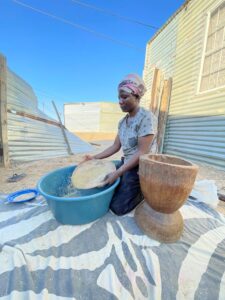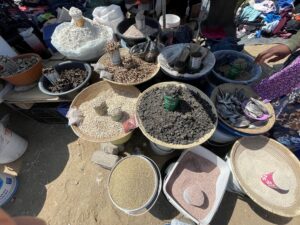The Sa’ban of Borneo: Comparative Study of the Sa’ban in Sarawak, Malaysia and Kalimantan, Indonesia
Research background The Sa’ban are one of the smaller indigenous peoples living on Borneo Island, Sarawak, Malaysia, an…

Photo 1. Sifting pearl millet grains (Omahangu) with traditional basket (Oshimbale) after manual pounding for decortication, at informal settlement Havana, Katutura
Katutura, the research site for this study, is the main informal settlement in Windhoek. After independence, many people from the north (mainly the Ovambos) migrated to Katutura in search of employment opportunities in Windhoek [Frayne 2007]. However, most of the residents there are unemployed or rely on income generated from petty jobs or piece work. Female-headed households, as the most financially struggling group [Mbongo 2017], are more susceptible to food insecurity [Nathanael 2023].
Traditionally, the major staple for Ovambos is mahangu (pearl millet) and anything that goes with is Oshivelelwa (including foraged plants, legumes, nuts, fish, or meat) [Rodin 1985]. However, in bigger cities like Windhoek, Westernized, industrialized foods have increasingly become the mainstream. At the same time, due to drastic climate changes and frequent happenings of draughts, decreased yields in crop harvests have made it difficult for subsistence farmers in rurual areas to survive, which directly results in reduction of food transfers to other family members living in the cities. Hence, it remains a question as to whether residents in informal settlements are still consuming traditional, indigenous foods as they did in Northern Namibia, and if the strategies they currently utilize are effective enough to meet their food diversity and quantity needs.
Previous studies indicate that food transfers are one of the major forms Ovambo residents in Katutura used to ensure certain amount of staple food. However, no qualitative data or detailed information was given. Also, novel approaches or solutions such as urban gardening are well worth exploring further. The purpose of this study is to investigate what attempts and/or strategies are being made by Ovambo female-headed households at informal settlements in Katutura to ensure sufficient energy intake, nutritional balance and dietary diversity.

Photo 2. Street stall selling traditional foods (millets, beans, wild greens, fish and meat), all dried up, at informal settlement Okuryangava, Katutura
I conducted my fieldwork among Ovambo residents at Havana, Okuryangava, Goreangab in Katutura, using approaches of participant observation, semi-structured and unstructured interviews. Also, I chose 3 key informants from different Ovambo sub-groups (Ngandjera, Kwambi, Kwanyama) with different education backgrounds, employment statuses, and household structures for case studies. Due to time limitation, I chose one of them for intensive case study and conducted comparatively thorough research on her life history. Through interviews, I realized that all informants interviewed (aged from late 20s to early 40s, both sexes) spent their childhood and youth in Northern Namibia and have been maintaining close contact with their (extended) family members in the North. Most of them visit the North and receive regular food transfer yearly from their kin.
Also, with the consent of the informant and providing appropriate compensation (in the form of weekly Airtime), I asked the informant for intensive case study to log her daily meals starting from end of August 2024 (during my fieldwork period) till present. Through the data already collected, it can be seen that dinner plays a vital role in daily meals and mahangu is still preferred as the first choice for staple.
Seasonal features should be taken account into the narratives, as it might greatly influence what kinds of foods are consumed by the households at Katutura. Because this fieldtrip was conducted in dry season when agricultural activities in Ovamboland are few and other logistical limitations, I did not capture the situations of food transfer in the north. Thus, further research during rainy season in Windhoek and in Ovamboland respectively is becoming a necessity.
Frayne, B. 2007. Migration and the changing social economy of Windhoek, Namibia, Development Southern Africa 24(1): 91–108.
Mbongo, L.T. 2017. Food Insecurity and Quality of Life in Informal Settlements of Katutura, Windhoek, Namibia, The University of Namibia, M.S. thesis.
Nathanael, S. V. 2023 (December 17). The Detailed Reality of Single Households Led by Women, Namibian.
Rodin, R. 1985. The Ethnobotany of the Kwanyama Ovambos. Lawrence, Kansas: Allen Press, Inc.
Copyright © 附属次世代型アジア・アフリカ教育研究センター All Rights Reserved.